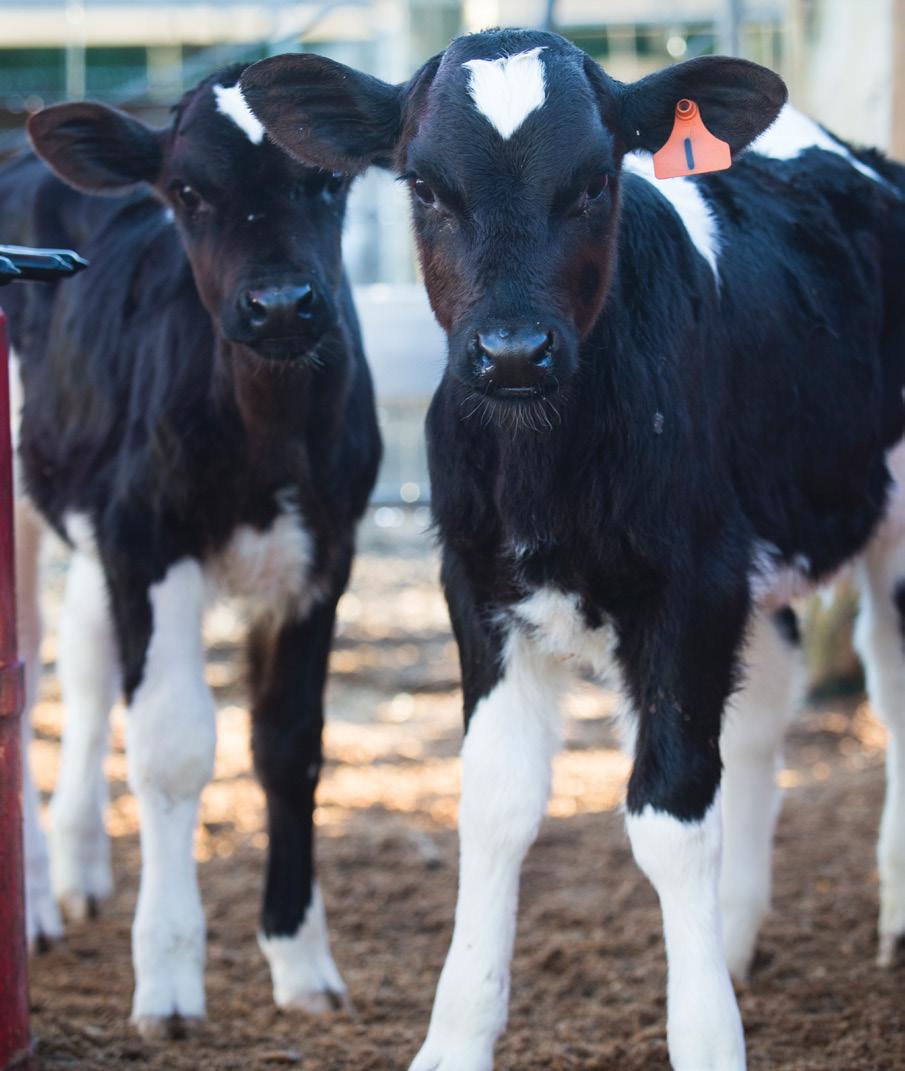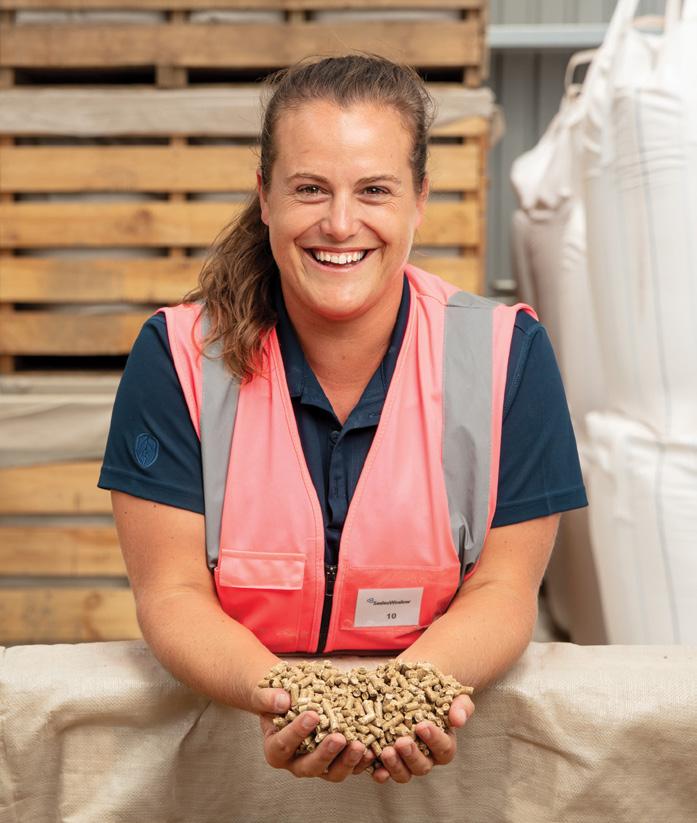
6 minute read
Getting the calf rumen up and running
Words by: Sheryl Haitana
Calves should be offered meal and have free access to clean water from their first day in the pens, says Natalie Hughes, SealesWinslow’s nutrition and quality manager.
Natalie hosted four webinars on calf rearing for the Dairy Women’s Network in June. The webinars topics were milk and colostrum; housing and pen design; feeding and meal; and heifers reaching liveweight targets. Water can often get overlooked in the first few weeks but it’s necessary for aiding the breakdown of feed within the rumen and supporting rumen bug growth, Natalie says.
“The longer we restrict calves from water the greater the negative impact on calves’ ability to digest feed.”
Calves are born with almost no immune system or bacteria in the rumen. They need to develop their rumen and those bugs to digest pasture and meal.
“We need water to create an environment for bugs and bacteria to grow in the rumen.”
Offering a small amount of meal from day one will also increase calves’ intake faster, she says.
“Calves are like kids, you’ve got to introduce it so they think it’s normal.”
She says calves are so inquisitive they will lick, smell and play with it. If it’s got molasses in it, it will get stuck on their nose and they’ll lick it off and start getting a taste for it.
Introducing meal early helps to develop the rumen so calves have the capacity to digest pasture earlier.
On a whole milk system there is little rumen development. On a milk and hay diet the muscle integrity in the rumen changes because it’s got to build more muscle to move that hay around.
On a diet that includes starches and sugars the rumen gets more blood supply and it develops the rumen capillaries, which increases the surface area of the rumen to absorb nutrients better.
“If we can get the rumen up and running, once they’re outside eating grass their rumen is at the capacity to start breaking down grass effectively.
“You get less of a growth check.”
There are many different types of meal and feed on the market. A lot of the decision drivers can come down to price/ tonne but Natalie says there are other considerations farmers need to factor in:
PALATABILITY
If they’re not going to eat it, what’s the point? We are going to spend a lot of money and the calves are not going to grow if they’re not going to eat it.
To preserve palatability, farmers need to store calf meal well and remove plastic shrink wrap from around bagged calf meal – it’s not waterproof and it makes the meal sweat.
You want the last bag to be as palatable and fresh as the first.
Bulls and Semen


Ezicalve make the best and safest beef bulls for dairy heifer and cow mating
Ask William Morrison 027 640 1166 and Mike Cranstone 027 218 0123 why their Ezicalve bulls are different, safer and better! www.ezicalve.co.nz
ENERGY
A calf’s rumen is so small that the amount they do eat needs to have the maximum amount of impact. The National Research Council (NRC) recommends for a new calf diet the feed should be 13ME. The energy should be coming from good quality grains. Watch out for high fat fillers. We want it to be high energy and energy dense.
HIGH QUALITY PROTEIN
When it comes to calf feed, a good vegetable protein is important to give calves the right amino acids. Proteins such as soybean, sunflower, peas, canola etc can be broken down and rebuilt by the bugs in the rumen into the right structures that help a calf grow.
NO LOW-QUALITY FILLERS
A calf’s stomach is small so the feed shouldn’t be bulked out with a cheap, low-quality filler if it’s adding no value. To develop rumen papillae calves need starches and sugars. NRC recommends a 35-40% starch concentration.
Palm kernel only has about 4% starch, so while it can be feed to animals, aim for over 100kg liveweight before it is added into the diet. It is not beneficial to use in a calf feed for younger calves to develop their rumens.
EXPRESSIONS OF INTEREST DAIRY EQUITY POSITION - MANAWATU
Do you have a passion for excellence and a history of high performance? Are you looking for that next step in the industry? Our clients are looking for someone they can trust who will perform well and become the driver and owner of their business. An outstanding 380ha property in the golden circle 15Km north east of Feilding has been made available for someone to buy into as the current owners wish to take a step back from the day to day running of the property. It has been developed over the last 30 years into one of the most admired dairy farms in the area – but there’s plenty of “blue sky” for the new partnership moving forward. Advantages here start with high quality LUC 1 & 2 versatile soil types that allow for supplementary feed or cash crops to be grown on farm. A focus on soil fertility and pasture renewal has ensured this place grows a lot of pasture. Great infrastructure on farm including the 80-bail rotary located in the middle of the property flanked by high quality calf rearing facilities and sheds, a gravity driven effluent system, plenty of water for stock and a 500- cow feed pad. Three well-presented recently renovated homes are available for use by the farming team. Historically the 380ha milking platform has been milking 1200 cows, with the farm producing 1,175kg MS/ha on average over the past 6 years. Options for education are abundant in the local rural community, with Feilding and Palmerston North close by. With a proposed start date of 1st June 2021 and flexibility in the investment options, we are seeking expressions of interest at this early stage.

For an expression of interest form, please contact Melissa on melissa@bakerag.co.nz

Natalie Hughes, SealesWinslow Nutrition and Quality Manager.
LOW IN FAT
Calves struggle with fat from a palatability point of view. The fat can also coat the feed in the rumen and the bugs can’t break it down. Aim for less than 4% fat.
VITAMINS AND MINERALS
Calves cannot generate their own B vitamins until their rumen is fully up and running. Ensure that the calf meal contains these essential components.
COCCIDIOSIS
Make sure to feed the right amount for the size of the calf. You can still get coccidiosis if you’re not feeding enough. For example, a 65kg calf should be eating 1kg of meal to be getting the right volume of coccidiostats in their diet. This can vary from one calf feed to another so best ask your supplier what volumes you should be aiming for.
CRUDE PROTEIN 16% VS 20%
When making the decision between feeds with 20% and 16% crude protein, work out how much a calf has to eat to achieve the weight gain you want, thus working out the true cost. A trial on AgResearch’s Pukawa Station looked at weaning calves off milk at 65kg within six weeks. One mob was fed 20% crude protein pellets and the other mob 16%.
Of the mob fed 20%, 47% got to 65kg in six weeks; only 21% of the calves fed 16% got to 65kg in that time.

• To sign up to hear more from Natalie in her DWN webinars visit www.dwn.org.nz
Part 7 - Encouraging Hard Feed Intake
www.youtube.com/ watch?v=mLhmQKU4MpA










